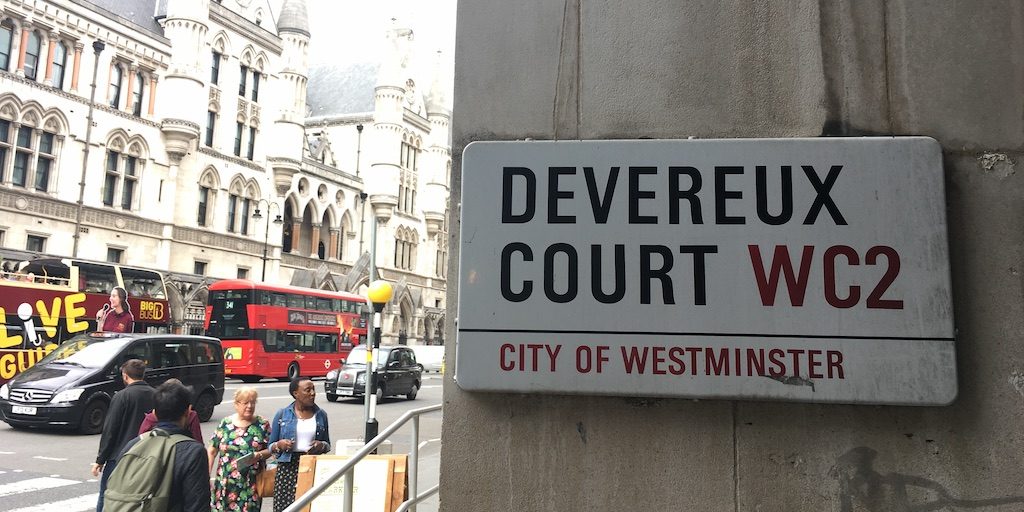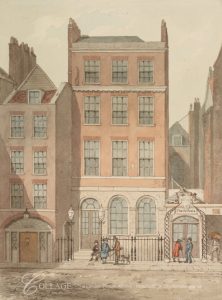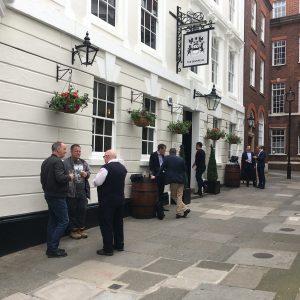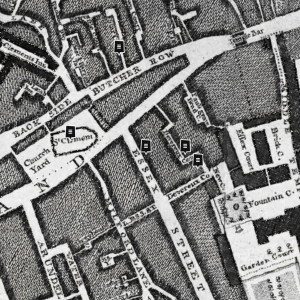Eighteenth-century lives in Devereux Court
Posted in 1700-1799, 18th Century, coffee and tea houses, houses, people, Places, pubs, Stories, Strandlines, workers and tagged with Aldwych, Clare Market, coffee-house, Devereux Court, east Strand, Grecian Coffee House, History, Royal Courts of Justice, St Clement Danes, strand, tea, Twinings

Micah Anne Neale is a 3rd-year PhD student at Royal Holloway, University of London, and volunteered for Layers of London in Summer 2019. Her thesis topic is the musical lives of eighteenth-century domestic servants in Britain, and her research interests include early modern social and cultural history, the history of work and the history of gender.
Devereux Court, a narrow lane south off the Strand just east of Essex Street, still has a few intact seventeenth-century buildings; the dog-leg route of the court has not changed since it was laid out in the 1670s, on the site of Essex House, a grand old house with extensive gardens.
Working for the Twining Family

Snow’s Banking House and Twinings Inn merchants, Strand, c. 1810, by George Shepherd. Image via COLLAGE, the London Picture Archive / City of London / London Metropolitan Archives.
Coming from the Strand, on your left as you go around the first bend is 9 Devereux Court, formerly the Twinings building, rebuilt in 1952 after wartime bombing destroyed the original buildings. Roughly where the entrance to 9 Devereux Court is now would have been the entrance to Tom’s Coffee House, bought in 1706 by Thomas Twining.
Several members of the Twining family were born in Devereux Court, even though the family had residences elsewhere. From the parish settlement examinations, we know that one Mary Evans served the family for just over a year, quitting in 1746.
Mary Evans was about 39 when she was hired, and was paid £7 a year. This put her among the very highest-paid of live-in maidservants: my research suggests this put her in the top few percent of female servants. This generous salary probably indicates that her skills – whether they were in housework, childcare or cooking – were highly valued by the Twinings.
By the end of the eighteenth century, the Twinings owned all of the east side of Devereux Court up from here to the Strand, with a banking-house, a family residence and a warehouse all growing into one communicating complex of buildings.
The real Greek at the Grecian Coffee House

The Devereux pub today.
Going round the dog-leg and facing south on Devereux Court, you will see the gate into the Temple on the left, and the court bending sharply to the right to join with Essex Street. Just before the gate and the bend to the right are two buildings constructed by Nicholas Barbon in 1675/76: Devereux Chambers and the Devereux public house.
The Devereux is a building with a very interesting history. Almost as soon as the building was finished, it became the new home of the Grecian Coffee House, a hotbed of genteel political and literary thought. Literary figures including Joseph Addison, founder of the Spectator, met there, as well as scientific luminaries – Isaac Newton, Edmund Halley and Sir Hans Sloane all frequented it.
One of the servants who might have inhabited the Grecian Coffee House’s drafty garret, up amid the low, heavy coal smog that blanketed London, was Angelo Trogar. In 1752 his wife was examined for parish settlement, presumably because she was claiming poor relief. Margaret Trogar remembers that she married her husband in ‘the Greek Chapel in Change Court upwds. of 30 years ago’, and that before her marriage her husband had worked for his uncle, George Constantine, a former sailor and owner of the Grecian Coffee House.
Angelo was paid £12 per year, which made him better-paid than 90% of male servants in the parish. However, it would not have been enough to live on unless he was provided with free room and board, since even unskilled labourers tended to demand £20 a year or more to sustain a family.
A young migrant in a highly xenophobic country, Angelo must have been grateful to his successful uncle for a solid start in his career. However, the mixing of familial, friendly and business relations that was ubiquitous in early modern life – your choice of friends could furnish or ruin your career at the drop of a hat – allowed quietly abusive dynamics to flourish. Read more about the characters of Devereux Court in the eighteenth century on Layers of London.
Recovering St Clement Danes

Detail of John Rocque’s map of London, Westminster and Southwark (1746), via Layers of London, original images provided courtesy of Patrick Mannix/MOTCO.
The parish of St Clement Danes, and especially the Clare Market area, just to the north of Devereux Court, has been transformed beyond all recognition by nineteenth-century developments. Between 1866, when site clearance began for the Royal Courts of Justice (obliterating an entire ward of the parish housing 5000 people), and 1908, when Kingsway was completed, most of St. Clement Danes’ early modern and medieval architecture was destroyed.
My collection on Layers of London, mapped on John Rocque’s 1746 map, brings together surviving 17th- and 18th-century architecture with information about the history beneath some of the parish’s more recent urban fabric. You will find a lively cast of characters mentioned: in the 17th and 18th centuries the area’s residents were economically and socially diverse, and the major thoroughfares that ran through it, principally the Strand and Drury Lane, brought many shoppers, commuters and travellers to the parish.


[…] in 1722 deranged in an agony of gout). This Tom’s was tucked on the corner of the Strand and Devereaux Court. The rival Grecian Coffee House opposite boasted Sir Isaac Newton, Sir Hans Sloan and Dr Halley, […]
A Black man Jack Beef, formerly enslaved by John Baker in St. Kitts, died in Devereaux Court on 6 January 1771. He was lodging with a ‘Mrs. Warren, barber’. See Philip Yorke, The Diary of John Baker, Barrister of the Middle Temple, Solicitor-General of the Leeward Islands, 208; Burial of ‘John beef from St. Clements’, 9 January 1771, St George’s Bloomsbury; Gretchen Gerzina, Black London, 48.